Port Simpson Residential School (Crosby Girls’ and Boys’ Home)
Port Simpson Residential School (Crosby Girls’ and Boys’ Home) Timeline
Dates of Operation
Girls’ Home 1879–1948; Boys’ Home 1890–1914
Girls’ Home operated by the Women’s Missionary Society of the Methodist Church, and after 1925, by the United Church. Boys’ Home operated by the Methodist Missionary Society.
Location
Lax Kw’alaams (Port Simpson), on the north coast of British Columbia, 40 kilometres north of Prince Rupert.
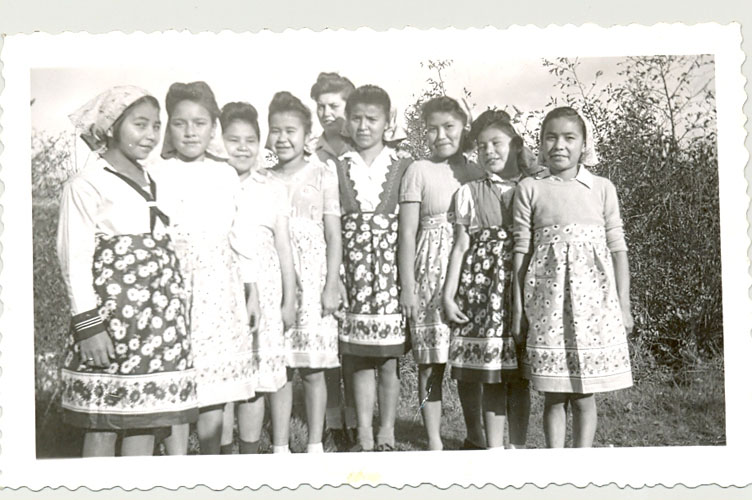
This school means a place where if you want to do something and the teachers say “No girls, you must not do that,” we are to go away with a smile, not to grumble and be bad girls because the teachers know what is best for us.
—Catharine White, grade 5, “What the Crosby Girls’ School Means to Me,” 1943 yearbook, accession 1998.165c, file 2, UCCA.
This school means a place where we have a lot of fun, where we learn how to act to visitors, and to be polite and tidy. This school is a place where we are trusted to go outside the fence and pick berries and play ball.
—Rena Lawson, grade 5, “What the Crosby Girls’ School Means to Me,” 1943 yearbook.
In 1874 Methodist missionary Thomas Crosby and his wife, Emma, arrived in Lax Kw’alaams, the Gispaxlo’ots village known in English as Fort Simpson, and later, Port Simpson. Located on the north coast of British Columbia, 40 kilometres north of Prince Rupert (which only overtook it in prominence in the province after the railway arrived there in 1914), Port Simpson was a community of some 3,000 people, the site of a Hudson’s Bay Company outpost, and an important centre for the Tsimshian of the lower Skeena River. Thomas Crosby used the village as a home base from which to conduct missions “up and down the coast” as well as inland along the Nass and Skeena rivers.
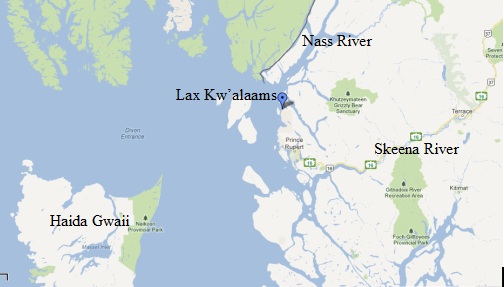
Instrumental in bringing the Methodists to Port Simpson were members of the high-ranking Dudoward family—the Tsimshian matriarch Dieks, her son Alfred, and his wife, Kate—all early converts to Methodism who facilitated the first missionaries’ pastoral and educational work in the village and the surrounding territory. Alfred and Kate started the first day school in Lax Kw’alaams, attracting some 200 students.[1] Kate Dudoward was Crosby’s interpreter for much of his mission work.
In later years, both Alfred and Kate, as well as many other Tsimshian people, became disillusioned with the Methodist Church. Not only did the church oppose many traditional Tsimshian cultural ceremonies but the sacrifice of such practices in favour of conversion did not bring economic development to the village or protect Tsimshian lands and resources from expropriation. Alfred ended up defecting to the Salvation Army, which arrived in 1895, but Kate’s break with the Methodists was less definitive.
Kate Dudoword’s unhappiness stemmed also from seeing herself and her family marginalized in the educational work they themselves had initiated. When her daughter, although she had teaching experience, was passed over for a position, Kate noted, “All this while [the school teacher’s] sister was helping him with the few pupils at last Mr. Ousterhout found out that [the schoolteacher] had given his sister-in-law the place of the Native assistant teacher, and that a lady was coming out for the Boys home.” [2]
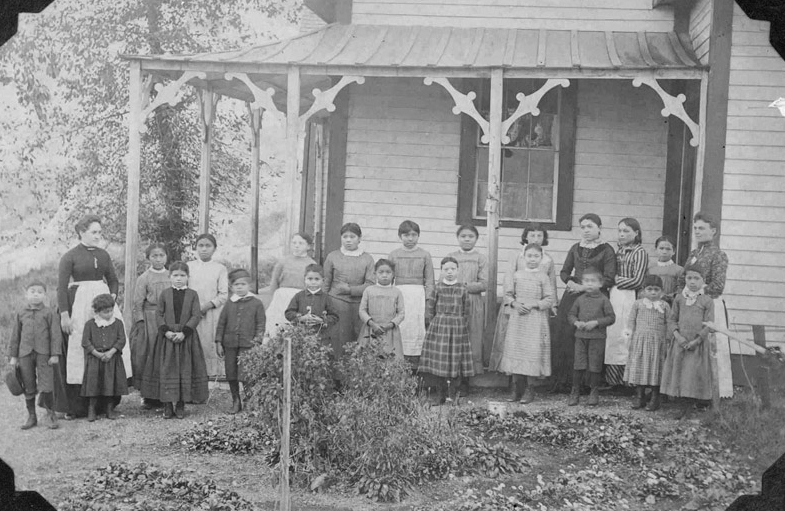
Emma Crosby, who generally did not accompany her husband on his trips, nonetheless found plenty of missionary work to attend to in Lax Kw’alaams. Her interests centred first and foremost on Tsimshian and other Indigenous girls, whom she—like Christian missionaries generally—felt were in particular danger of degradation. What would become the Crosby Girls’ Home had its roots not in education but in Emma Crosby’s desire to “protect” these girls—in particular, orphans and “outcasts”—from what she considered to be “a life of dissipation and shame.”[3] The year after she arrived in the village, she began inviting girls to live in her home. By living together with the girls, she hoped to model “what a well-ordered Christian home ought to be” and into the bargain got assistance with her own growing household (she bore eight children in the 23 years she was at Port Simpson, four of whom died there), the more critical because her husband was so often away.[4] Within a few years, however, Emma decided that her own children, who “learned to talk Indian before English from their association with these girls in their home,” needed a Christian household of their own.[5]
The First “Home”
In 1879, the Crosbys built an addition on the mission house and separated their own quarters from that of the “Girls’ Home,” which soon also got its own matron, thanks to the Women’s Missionary Society (WMS). In 1883, when a new mission house was built, the Crosbys moved out altogether, leaving the entirety of their old house to their former boarders and their matron. A measles outbreak the same year saw almost every girl taken ill. Two of them died, the first deaths in the Girls’ Home.[6] In 1887, with 20 girls in residence, the WMS added a second staff member.
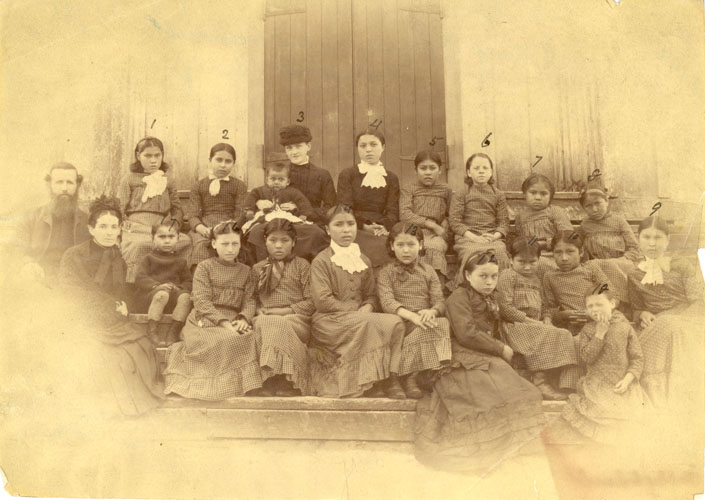
Life in the home was highly regimented, and discipline was strict. “We do everything by rule,” wrote Principal Knight in 1886. “We have bedroom, dining-room, kitchen and washroom rules, also general rules, or a timetable giving the hour for everything, from the rising-bell to bed-time. I found it impossible to get on in any other way.” [7] The children, who at that point numbered 14 girls and one little boy, took turns cleaning and cooking, with younger girls paired off to assist the older ones. “They all attend school in the morning (the public school), except the one who is cook for the time being; and in the afternoon I keep the older ones at home to sew,” wrote Knight.[8]
However, the home also depended on the girls’ knowledge of local food sources and their preparation. In spring they collected fish eggs; in summer, berries, which they preserved for the winter; and in winter they sought permission to gather mussels and clams. Knight observed that they “have a wonderful facility for finding something to eat every time they go out; sometimes it is mussels off the rocks, sometimes roots or young shoots, or various plants which they tell me ‘the people eat,’ so they know they are safe.”[9]
Girls in residence did not bend easily to the rigidity of home life, however. As Emma Crosby noted, “It is very hard for some of these girls to stand restraint for any length of time, so accustomed are they to a life of freedom and change.”[10] The methods used to ensure obedience were often severe. In 1883, when Thomas Crosby could not find any boys to cut the lumber for the home, he turned to the resident girls with the result that a girl from a high-ranking family and her friend refused and then ran away. “Lucy the eldest of the 2 being a Princess felt it beneath her dignity,” Principal Hendry explained in reference to their actions. A constable brought the pair back “& they were locked in our work room nearly a week where I fed, talked to & prayed with my 2 prisoners every day.”[11] Even in her description of the mission house—now the Girls’ Home—Hendry hinted at the aura of discipline that defined the place: “upstairs the girls bed rooms 2 large store rooms & some dark corners to put the naughty children in.”[12]
A New Building
By the 1890s, the Women’s Missionary Society had replaced the Crosbys as managers of the home. The society purchased two acres of land outside the Tsimshian reserve and built a new home with room for up to 50 girls. In May 1892, three teachers and 29 girls moved in, and the Department of Indian Affairs recognized the home as a residential school and started providing annual per capita grants—beginning at $60 per student to a maximum of 20 students.[13]
While most of the girls continued to come from Port Simpson, the home also drew Tsimshian and Gitxsan girls from communities up the Nass and Skeena rivers and Haida girls from Haida Gwaii. In addition to “orphans,” the home population expanded to include girls from families who wished to see them educated and trained in Christian ways. Parents of these girls were obliged to sign over their daughters for a period of up to ten years and to pay for their clothing needs throughout their stay.[14]
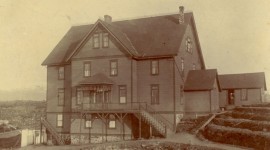
In the new building, the girls no longer attended the day school for their classes. Nor did they receive summer vacations. The subjects the girls were taught consisted of reading, writing, spelling, dictation, grammar, geography, history, hygiene, music, Bible history and doctrine, and the Methodist catechism. [15] They were also instructed in general housework, laundry-work, cooking and bread-making, sewing, knitting and fancy work. [16] “They learn to make and keep in repair all their own garments; and when we realize that in addition to the making and mending and school work, most of the manual labor connected with the house-keeping is performed by the girls, we understand that a great amount of work is accomplished during the year,” the WMS reported proudly.[17]
Some of the girls’ needlework was sold to support the home and the new hospital, and older girls were hired out to settlers as domestic servants—a number to Emma Crosby.[18] There was no land suitable for extensive farming, so “native” food—salmon, seaweed, small fish, and game—had to be purchased from the villagers.[19] A small garden and henhouse supplemented these purchases.
Illness and epidemics were an ongoing problem at the home, as the Women’s Missionary Society itself recognized: “Among the Indian children, with their weak constitutions and scrofulous tendencies, epidemics of influenza, measles and other diseases, with their attendant complications, are always serious and often fatal.”[20] Records are incomplete, but Principal Livinia Clarke, for instance, reported 12 deaths during her three-year administration (1899–1902).[21]
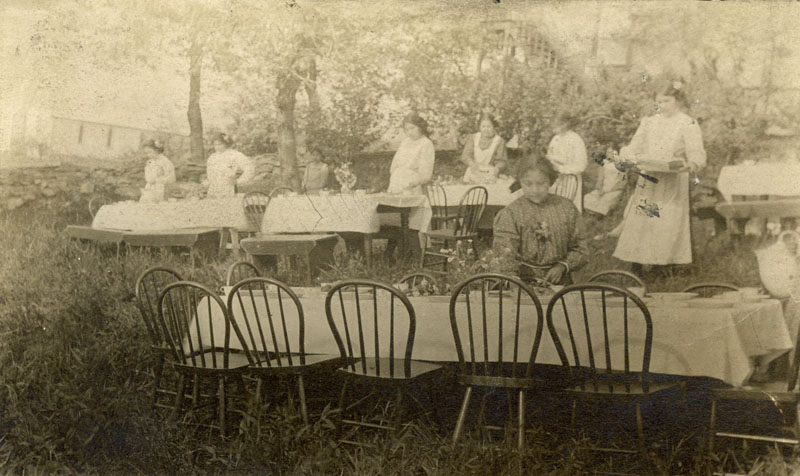
In 1897, Principal J. Redner described the home’s disciplinary measures: “The punishments most frequently used are private and public reproof, sending pupils to their rooms, and in extreme cases, whipping or solitary confinement.”[22] The home’s hold on the girls was not absolute, however, and in time, the WMS found they had to relax it further. Redner, for instance, let a few of the older girls join their families at the canneries during the fishing season.[23] And by 1915, the WMS had adopted the Department of Indian Affairs’ (DIA) suggestion of granting their students a month’s holiday. “This month’s vacation was undoubtedly beneficial physically, but of the moral effect we do not feel so confident,” home authorities reported. “However, it is more and more felt that the parents’ right and control must be recognized, and that through the girls the people, too, may be uplifted, for it is the life to which they must return.”[24]
Crosby Boys’ Home
At the same time the WMS was building the new Girls’ Home, the Methodist Missionary Society was busy setting up a similar institution for boys on mission land on the southeast side of the village, about 400 metres from the waterfront.[25] Construction began in the summer of 1889, and the Crosby Boys’ Home opened in October 1890, with Dr. Bolton in charge. Six boys who had been staying in the Girls’ Home were transferred there.[26]
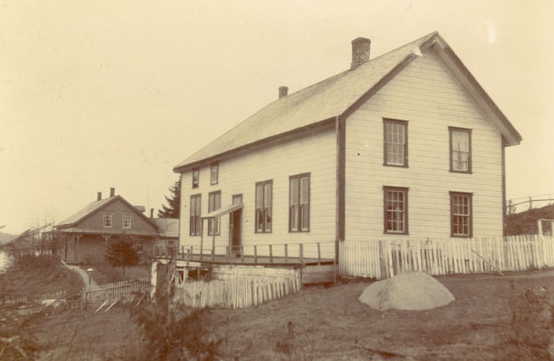
In 1896, Chief Albert Shakes and the Tsimshian chiefs and council petitioned the Minister of the Interior to finance the boys’ boarding school. They explained, “During at least six months in each year most of our people are engaged in fishing and hunting which make it necessary for them to be away from Port Simpson during that time and they are obliged to take their boys with them thereby depriving them of educational facilities.” The petitioners emphasized that they did not want their boys sent away to school or taught by a denomination other than Methodists (for example, by the Anglicans, 90 kilometres away in Metlakatla).[27]
Government financing did not come, however, until 1902. By that time there were 15 boys in residence. By 1905 there were 24, from Port Simpson as well as from reserves on the Nass and Skeena rivers. Boys at the home were taught gardening, carpentry, shoemaking, general housework, bread making, and “the use of the needle,” as well as prayers, catechism and daily Bible lessons. They took their academic classes at the day school. As the growing season was short and the school grounds “wet and boggy,” garden produce was limited to cabbage, carrots, turnips, beets, rhubarb, and a variety of berries, from which the boys prepared “pailfuls of jam.” They also kept hens and a few cows for milk and butter. Like the girls in the Crosby Girls’ Home, the boys supplemented the institution’s resources with salmon they fished during the spawning season, cranberries picked in the surrounding hills, and fish eggs gathered from the seashore.[28]
Discipline was strict, and—according to at least one former staff—abusive. In 1898, Elizabeth Shaw, a relief matron who worked at the home for five weeks, wrote a scathing letter to the WMS condemning the mistreatment of boys in residence there: “The slightest mistake on the part of the boys brings down the wrath of the authorities, and the severe floggings which were the almost inevitable consequences of wrongdoing seem to me in many cases to be out of all proportion to the gravity of the offence.”[29] Her letter sparked a half-hearted investigation. But after Thomas Crosby declared Shaw “crazy” and warned that “the consequences on the Indian mind” of further investigation “would be of a most serious character,” the matter was dropped.[30].
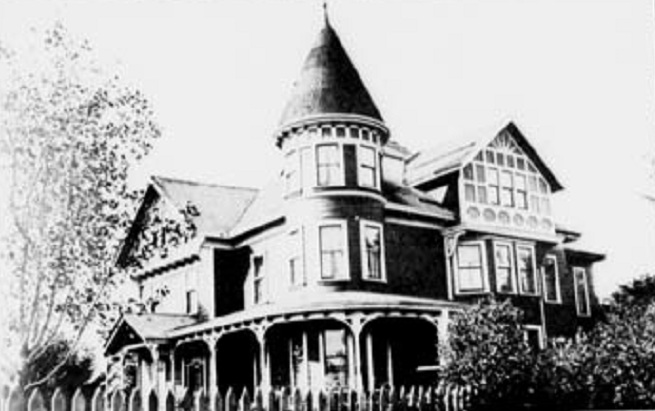
In 1905, Tsimshian community members, backed by the Methodist Church, started petitioning to have the boys’ and girls’ homes combined into a single co-ed industrial institute like the Coqualeetza Industrial Institute, at Sardis.[31] The DIA, however, refused to build more schools. Meanwhile, conditions at the Crosby Boys’ Home deteriorated until in August 1914 it had to be closed. According to the school inspector, the school building “had become unsanitary and badly out of repair.”[32] Attempts had been made to find a new site for the home, but no agreement on land could be reached with the Port Simpson Tsimshians, who had just lost four reserves totalling 11,000 acres as a result of the “cut-offs” ordered by the McKenna-McBride commission.[33] Ten of the resident boys were sent to Coqualeetza, more than 800 kilometres away, and the rest were discharged.

n the years that followed, it appears that Tsimshian community members came to regret not having provided land for another boys’ home. They repeatedly petitioned for a residential school for their boys, eventually offering land for it “from one hundred up to four hundred acres if necessary.”[34] In their arguments, petitioners cited the irrelevance of the agriculture-centred training provided at Coqualeetza for fishing communities of the northern B.C. coast.[35] And they claimed that the change of climate in the south was affecting their children’s health: “Many have returned only to become invalids, so that it seems useless to try and educate a student, in surroundings in which it is difficult for them to maintain their proper health.”[36] The chiefs were also concerned that graduating girls would not find suitable marriage partners unless Tsimshian boys received a comparable education.
The DIA, however, calculated that a school in Port Simpson would result in the withdrawal of Coqualeetza students who came from northern British Columbia—more than half the school’s population.[37] Officials considered the Girls’ Home and the day school sufficient for Tsimshian needs. The Tsimshian, however, continued to petition for a boys’ or a co-ed residential school without success until 1931.
Fire, Reconstruction, and Closure
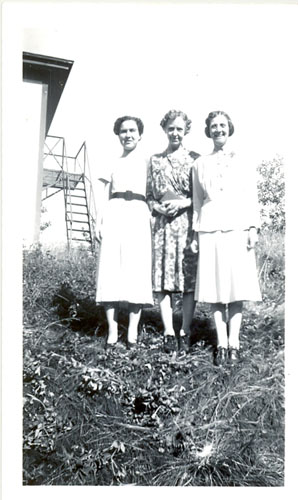
In 1921, the Crosby Girls’ Home burned down. The WMS rebuilt, with a slightly smaller building for a student population that never surpassed 30. In the 1940s the number of students began to decline, and by 1946, problems among the staff were having a disruptive effect on the girls: “The children have been disobedient and defiant,” the Indian Agent reported that spring. “The WMS plans to change the whole staff in September.”[38] The village boys were also a source of concern. When the Indian Agent recommended hiring a night watchman, he gave as reasons both the risk of fire and “a lot of trouble with native boys at this school.”[39]
The following year, enrolment had dwindled to six students, and the district inspector recommended closing the home for good: “The operation of this school has been unsatisfatory for a number of years, and it is my considered opinion that there will not be any great improvement as long as this old building with its inadequate plumbing, playground facilities and lack of space is used.”[40] The home struggled on for another year, with eight girls—all orphans or from “anti-social surroundings”—in the care of Principal Moats and two staff the Indian Agent described as elderly but “anxious to do their best.”[41] The Crosby Girls’ Home closed June 30, 1948.
Footnotes
- Jan Hare and Jean Barman, Good Intentions Gone Awry: Emma Crosby and the Methodist Mission on the Northwest Coast (Vancouver: UBC Press, 2006), 69. In 1874 and 1875, Kate and Alfred Dudoward appear on the DIA’s list of salaried day school teachers in Port Simpson. See DIA annual report (online), 1874, part II, p. 106; DIA annual report (online), 1875, part I, p. 82. ↩
- Susan Neylan, Heavens are Changing: Nineteenth-Century Protestant Missions and Tsimshian Christianity (Montreal: McGill-Queen’s University Press, 2002), 145. ↩
- H.L. Platt, “The Crosby Girls Home,” ch. 3 in The Story of the Years: a History of the Woman’s Missionary Society of the Methodist Church, Canada, from 1881 to 1906 (n.p.: [Women’s Missionary Society Methodist Church Canada], 1908), vol. 1, p. 32. ↩
- Ibid., 40; Hare and Barman, Good Intentions Gone Awry, 122, 142. ↩
- Platt, “The Crosby Girls Home,” 32. ↩
- Ibid., 229. ↩
- Ibid., 34. ↩
- Ibid. ↩
- Hare and Barman, Good Intentions Gone Awry, 253. ↩
- Cited in Hare and Barman, Good Intentions Gone Awry, 230. ↩
- Ibid., 231. ↩
- Ibid., 233. ↩
- Martin Benson to Deputy Secretary General of Indian Affairs (SGIA), May 9, 1905, RG10, vol. 6458, file 886-1, pt. 1, Library and Archives Canada (LAC). ↩
- Hare and Barman, Good Intentions Gone Awry, 259; Platt, “The Crosby Girls Home,” 39, 44. ↩
- Livinia Clarke to SGIA, July 10, 1899, Department of Indian Affairs (DIA) annual report, 1899, pp. 387–388. ↩
- Ibid. ↩
- Platt, “The Crosby Girls Home,” 39–40. ↩
- IIbid., 40; Hannah M. Paul to SIGA, DIA annual report (online), 1903, p. 416; Paul to SGIA, June 30, DIA annual report (online), 1904, p. 395; Hare and Barman, Good Intentions Gone Awry, 232. ↩
- Platt, “The Crosby Girls Home,” 39. ↩
- bid., 42. ↩
- Clarke to SGIA, July 10, 1899; Clarke to SGIA, June 30, 1900, DIA annual report, 1900, p. 417; Clarke to SGIA, June 30, 1901, DIA annual report, 1901, p. 408. ↩
- Mrs. J. Redner to SGIA, June 30, 1897, DIA annual report, 1897, pp. 294–295. ↩
- Ibid. ↩
- E.S. Strachan and W.E. Ross, “Crosby Girls Home, Port Simpson, B.C.,” ch. 1 in The Story of the Years: a History of the Woman’s Missionary Society of the Methodist Church, Canada, from 1906 to 1916 (Toronto: Women’s Missionary Society Methodist Church Canada, 1917), vol. 3, p. 19.↩
- Charles Richards to SGIA, September 23, 1903, DIA annual report (online), 1903, pp. 414–415. ↩
- Hare and Barman, Good Intentions Gone Awry, 230. According to Martin Benson, head of the DIA’s Indian Schools Division, the Methodist Missionary Society established the Boys’ Home in 1888. See Benson to Deputy SGIA, May 9, 1905. ↩
- Albert M. Shakes et al to the Minister of the Interior, Aug. 21, 1896, RG10, vol. 6458, file 886-1, pt. 1, LAC.↩
- Richards to SGIA, Sept. 23, 1903; Richards to Frank Pedley, SGIA, August 1905, DIA annual report, 1905, pp. 357–358; “Port Simpson Boys Home (Methodist), Northwest Coast Agency,” DIA annual report, 1907, p. 435. ↩
- Cited in Eva Manly (dir.), The Awakening of Elizabeth Shaw, produced by Eva Manly and Paul Many (Nanaimo, B.C.: Manly Media, 1996), video. ↩
- Thomas Crosby to E. Robson, April 14, 1899, cited in Manly, The Awakening of Elizabeth Shaw. ↩
- A.S. Dudoward, Chief Councillor, et al, petition, [Apr. 20, 1905], RG10, vol. 6458, file 886-1, pt. 1, LAC. ↩
- “Report of Rev. R.H. Cairns, Inspector of Schools, on the Schools in British Columbia,” DIA annual report (online), 1915, part II, p. 240. ↩
- The McKenna-McBride Commission was established to determine the final Indian reserve acreage in British Columbia. It “cut off” Indian reserve lands deemed surplus to community needs. ↩
- T. Ferrier to Duncan C. Scott, Deputy SGIA, Oct. 12, 1920, RG10, vol. 6458, file 886-1, pt. 1, LAC. ↩
- Henry E. Nelson et al to the Government of Canada and the Missionary Society of the Methodist Church, Feb. 16, 1916, RG10, vol. 6458, file 886-1, pt. 1, LAC. ↩
- Dudoward et al to C.C. Perry, Indian Agent, Feb. 6, 1920, RG10, vol. 6458, file 886-1, pt. 1, LAC. ↩
- W.E. Ditchburn to Sir, Apr. [?], 1931, RG10, vol. 6458, file 886-1, pt. 1, LAC. ↩
- J. Gillett, Indian Agent, to D.M. MacKay, Indian Commissioner for B.C., Apr. 4, 1946, RG10, vol. 6458, file 886-1, pt. 2, LAC. ↩
- F.E. Anfield to MacKay, Nov. 1, 1946, RG10, vol. 6458, file 886-1, pt. 2, LAC. ↩
- R.F. Davey, District Inspector of Indian Schools, to the Indian Commissioner for B.C., Oct. 20, 1947, RG10, vol. 6458, file 886-1, pt. 2, LAC. ↩
- Anfield to MacKay, Nov. 25, 1947, RG10, vol. 6458, file 886-1, pt. 2, LAC. ↩